Quang Trung ChessTM
The Contest|| Zillions of Games |The Concepts | Introduction | A Brief Note | Object of the Gamel | Board+Pieces | Initial-Setup | Chariot | Cannon | Knight | Elephant | Counsellor | General | Pawn|
Read This First
Do not waste your time in reading about something you don't like or not interested. That
mean you don't have to read everything that I put down on this page. Skim through the
page. Hopefully there is something that might interest you.
About the Contest
Quang Trung Chess and about forty other chess games were submitted to a contest hosted by
David Howe. The four finalists will be the four contestants who received the most total
number of points voted in by visitors like YOU. If you haven't know: You are urged to cast
your vote (click on the VOTE button on the upper left side corner of this page).
To help you know what to look for when judging a game, ask yourself this question: "Does the game have any underlining purpose, principle, goal, or quality that chess or Chinese chess doesn't have?" With this important question alone, you could eliminate most of the games out of the contest as flawed. Why? --because you don't want anyone to waste your time by creating another game simply changing the existing rules here and there without any underlining purpose or structure. Why create a new game that is clearly inferior to the present game, right? With the remaining games, you could judge how efficiently each creator/author approaches the intended goal. I hope that this paragraph is helpful to you in voting for your favorite game.
Introduction
Take a quick look at the description of my game below. You might like it. But most of you
won't like it because you don't know what the heck I'm talking about. However, if you got
what it take to appreciate Chinese Chess and orthodox chess (FIDE), then you
definitely will love Quang Trung Chess.
If you decided to learn more about Quang Trung Chess, please don't judge the game until you have played it well because the game is designed to be played--not to be read.
Three of the seven pieces from Quang Trung Chess were adopted from other chess variants. Each piece came from a different variant: the cannon from (FIDE) Chess, the elephant from Tamerlane Chess, and the knight from Chinese Chess. The remaining four pieces are uniquely Quang Trung Chess. The chariot is designed so that it could be safely blocked. The general is designed to give check. The pawn is designed to eliminate the need for promotion. The counsellor is added since it is simply beautiful in its simplicity, geometry, and function.
The Object of the Game
Quang Trung Chess can be won by checkmating the opponent's general, or by moving a pawn to
its last rank in such a way that it could not be immediately captured. Stalemate is a
draw.
Board and Pieces
Quang Trung Chess is a two-player game. It is played on a 10x10 checkered board. See
figure-1 below. Initially, each side gets a total of 16 pieces: 1-general, 1-counsellor,
2-knights, 2-cannons, 2-elephant, 2-chariot, and 6-pawns. The board is outlined into three
sections. Through out the game, the generals and the pawns may only be in the middle
section (file-c to file-h).
The Set-up
The initial arrangement of the pieces is as in figure-1 below, where the kings are on
file-e while the counsellors are on file-f. White, on the bottom, moves first.
Figure-1

The Initial Set-up
The Rules
The rules are simple. No castling. No En Passant. No pawn promotion. However, do
read the description of each piece below very carefully--especially the description of the
general.
![]() The Chariot
The Chariot
The Quang Trung chariot moves in any number of paces at right angle.
However, its capturing style is unique. To capture, the chariot must jump one pace
immediately over the enemy piece, provided that the jump-to square is empty. Because of
this requirement for capturing, it is now possible to safely blocked the once powerful
chariot. See figure-2 below.
Figure-2
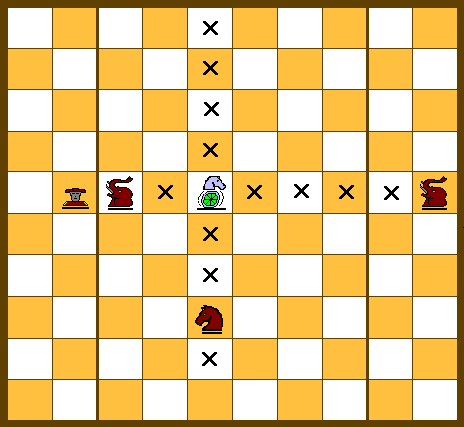
The Chariot
![]() The Cannon
The Cannon
The Quang Trung cannon moves and captures like the regular (FIDE) chess
bishop. In other words, it moves and captures diagonally in any number of paces without
jumping over any piece. See figure-3 below.
Figure-3
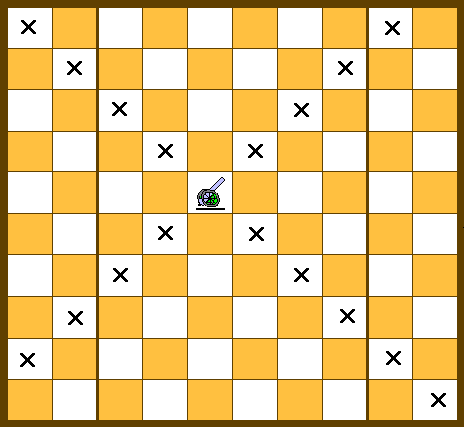
The Cannon
![]() The
Knight
The
Knight
The Quang Trung knight moves and captures exactly like the knight in
Chinese Chess. In other words, it makes one pace orthogonally into an empty square then
followed by another pace diagonally outward. Thus, it could not jump over a piece. See
figure-4 below.
Figure-4
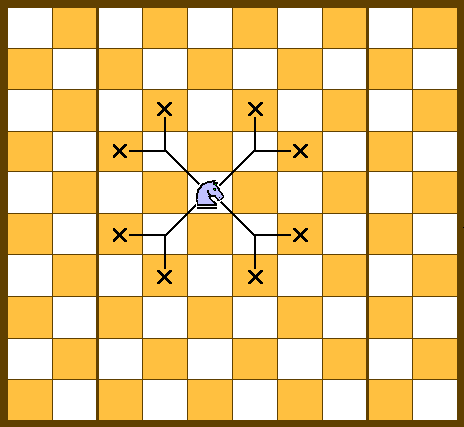
The Knight
![]() The Elephant
The Elephant
The Quang Trung elephant moves and captures by making two paces orthogonally then followed
by another pace diagonally away--just like the camel in Tamerlane Chess. Thus, the
elephant could jump over any piece. See figure-5 below.
Figure-5
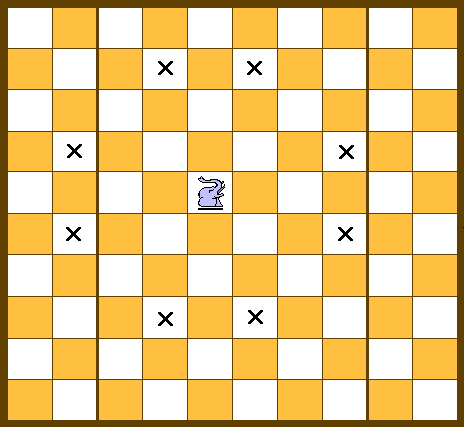
The Elephant
![]() The
Counsellor
The
Counsellor
The Quang Trung counsellor moves and captures three paces orthogonally or two paces
diagonally while jumping over any piece. See figure-6 below.
Figure-6
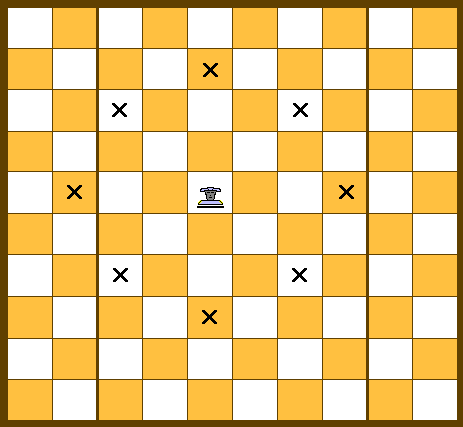
The Counsellor
![]() The General
The General
The Quang Trung general is the first "royal" in the history of chess variant
that could be able to give check without having to change its nature or having added rule.
However, it could be very difficult to comprehend its movement just by reading the
description alone.
Figure-7
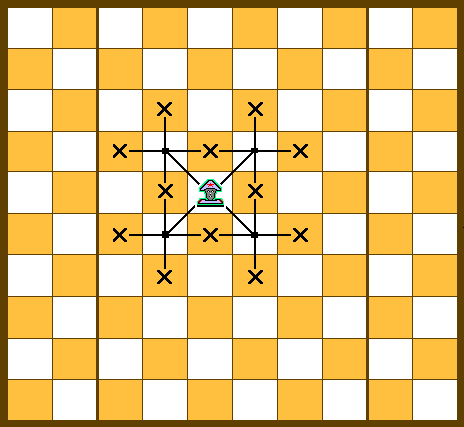
The General
The general moves and captures by making a pace diagonally into a vacant square and then followed by another pace orthogonally into a vacant square or an enemy occupied square, in which case the enemy piece is captured and removed from the board. The general must move and capture exactly in this order. The general and the pawn may only be in the middle section of the board--file-c through file-h.
Shown in figure-8 below is an example where a king is checking another king in a the most natural way. White general could capture black general, as shown by the path branched out from white general to black general. Black general cannot capture white general because the knight is in the way.
Figure-8
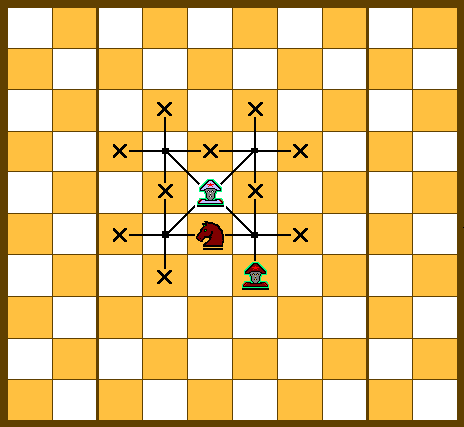
An example where the general gives check
![]() The Pawn
The Pawn
The Quang Trung pawn is the first pawn in the history of chess variant to have it
power maximized when it reach its destination. This effectively put an end to the headache
associated with promotion--as seen in (FIDE) Chess.
Figure-9
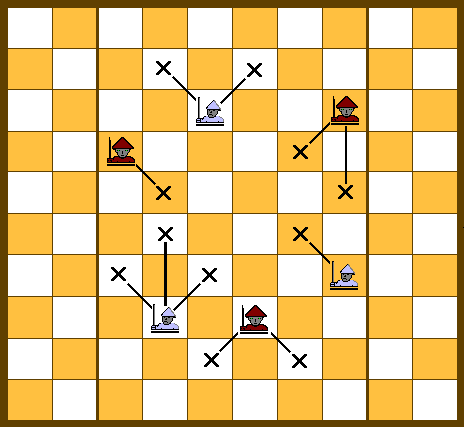
The Pawn
The pawn moves and captures by making one pace diagonally forward into an empty square or an enemy occupied square, in which case, the enemy piece is captured and removed from the board. On the pawn first move, it is also allowed to move two paces forward--without capturing or jumping over a piece. See figure-9 above.
When the pawn reach its last row, it automatically put the opponent's general in check, and automatically won the game if the opponent's could not capture it. The pawn and the general may only be in the middle section of the board--file-c through file-h.
A Brief Note on Quang Trung Chess
So far, almost all of the chess variants posted to the public are variants of (FIDE) chess
or variants of another version within the same family as (FIDE) chess. Quang Trung Chess
ignores all (FIDE) standard. Enough's said.
The idea for Quang Trung Chess was started in July of 1992. At that time, I was looking to create a new chess game for the Vietnamese because Vietnamese simply do not have a chess game to call theirs. (Cotuong is just another name for Chinese chess). Anyway, the first edition of Quang Trung Chess was completed on March 3rd, 1999 and shortly after released to the general public. On April 15, I made several important changes and additions to the game. The updated version is shown here. The old version should be discarded.
The game is named in honor of Emperor Quang Trung--Vietnam late 18th century military hero.
Zillions of Games Rules
If you have zillions-of-games solfware,
then download this file quangtrung.zip to play Quang Trung Chess.
New Concepts and Approaches
This section contains technical terms and concepts. Some audiences are advised to skip
this section. There are a few new concepts that were developed during the creation
of Quang Trung Chess. Some of them are listed below.
Board Size:
I feel that an 8x8 board is a little small while a 10x10 board is a little big. Therefore,
my board should not be out of that range. The board should be checkered, of course.
Board Perspective
A particular board dimension will always be too small for some pieces while still too
large for others since there are many types of pieces on the board. For example, if a
mouse and an elephant must share a room together, how large should the room be? In any
case, the elephant will always feel crowded while the mouse feel spacious. My approach to
this problem is to create a smaller board within a bigger board.
The Restriction
There is restriction on the number of pieces used in the game. There should be exactly
seven types of pieces (since I want the game to be "Vietnamese compatible" since
my target audiences are Vietnamese). In other words, my game should use all the available
chess pieces used in Cotuong while not introduce any new one.
Checking General
I feel that a "general" piece should be carefully selected since it is the piece
that remain through out the whole game. I notice that both of the "generals" in
two of the most currently popular chess games (FIDE chess and Chinese chess) could not
naturally give check. The "general" of my game will be the first game to have a
royal piece that possessed the natural ability to give check.
Goal Oriented Pawn
In order for the general to give check, both generals cannot be enclosed separately like
the way it is in Chinese chess. But letting the generals run wildly will leave the pawns
without a goal. In (FIDE) chess, to compensate for the running general, the pawns are
given a chance to promote to a more valuable piece when reaching the end. But promotion is
very arbitrary, to say the least. My approach to this problem is to eliminate the concept
of promotion totally. Or you could say that I take the concept of promotion to the
limit--that is, maximum promotion.
Keep It Simple, Stupid!
Keeping the game simple and short is an art in itself. Enough's said.
Written by Vu Q. Vo.
WWW page created: May 12, 1999. Last modified: November 27, 2000.